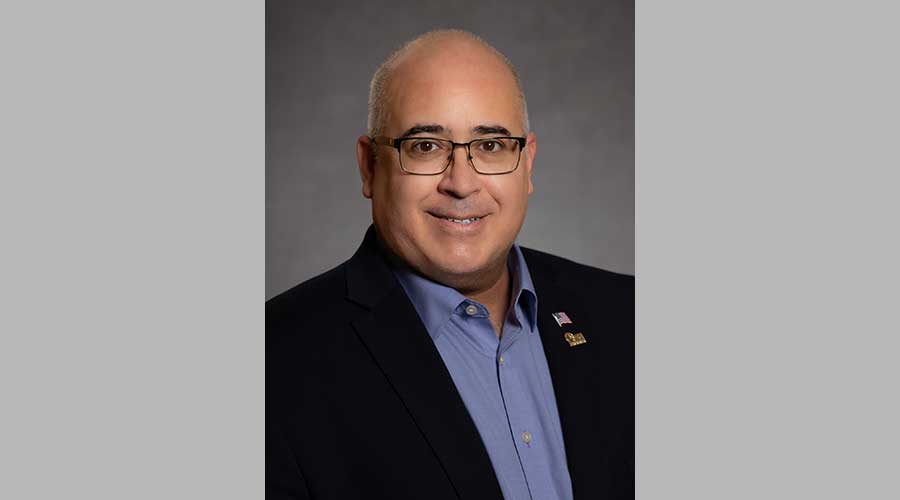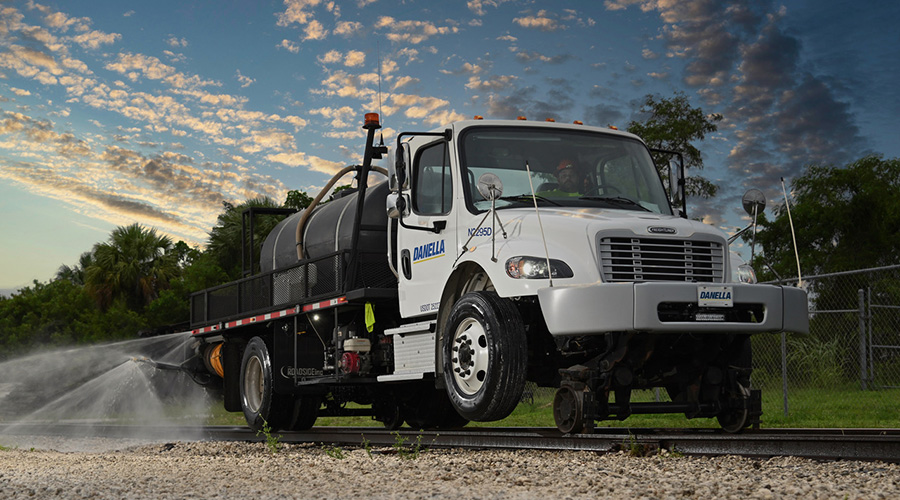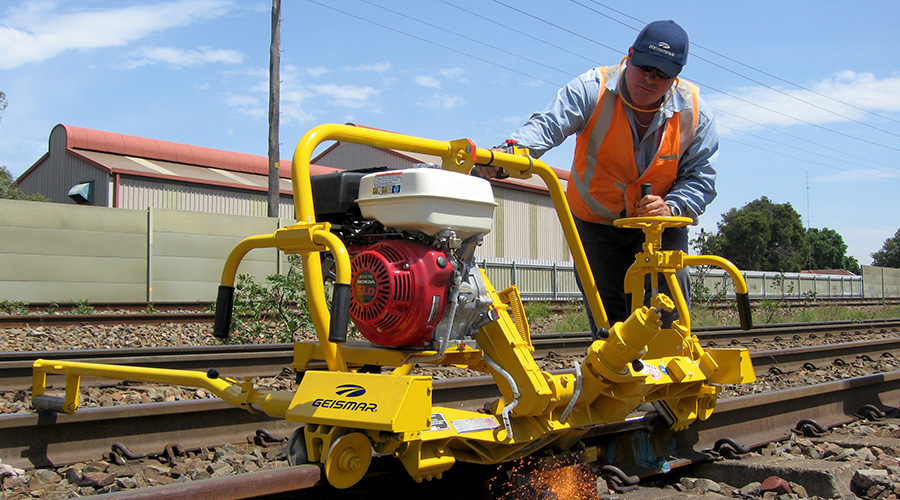Stay updated on news, articles and information for the rail industry
July 2010
Rail News: MOW
Maintenance of way: Bridge inspection services
— by Walter Weart
Bridges are vital structures in the national rail network, crossing major roads and rivers. And there are a lot of them. A September 2008 bridge survey conducted by the Association of American Railroads determined freight railroads and Amtrak own and maintain about 77,000 bridges.
Also in September 2008, the Federal Railroad Administration's (FRA) Railroad Safety Advisory Committee approved the first-ever agreement between the rail industry and FRA on standard rail bridge safety procedures. The pact covers inspection and maintenance practices that must be included in every bridge management program, such as a detailed inventory, design and safety rating procedures, and inspection processes. The pact also requires railroads to inspect bridges annually.
To help railroads monitor and maintain their structures, a number of engineering firms and contractors offer inspection and construction/repair services. The firms rely on their bridge expertise to find various defects and broken components during inspections, and pinpoint repair needs.
For example, HDR Inc., which performs inspections on timber, concrete and steel rail bridges, has been detecting such problems as washed-out bents, broken bridge members, rotten timber and fatigue cracks during annual and specially requested inspections for railroads.
HDR inspectors determined such defects can reduce a bridge's load carrying capacity or lead to problems in adjacent bridge members. Most defects are due to heavy loads, the number of trains that cross a bridge and a structure's age, HDR officials said in an email.
The engineering firm also can inspect simple, continuous and moveable-span bridge types, and perform underwater inspections and non-destructive tests via sub-consultants. In one case, HDR inspectors found three washed-out main channel timber bents on a bridge along an out-of-service line; in another, they verified bridge repairs that already had been recommended by a railroad.
"Even though a structure has been inspected for the last 10 years, each inspection must be performed as if it were the first time the structure was examined," HDR officials said.
All Things Large and Small
After inspections are completed, some Class Is have chosen to replace more of their larger and older bridges. Lately, more small railroads and public agencies are seeking bridge inspections to re-establish service on lines, HDR officials said.
"These clients want the inspection to not only record the structure condition, but also its load-carrying capacity, and provide information on the feasibility of restoring service over that structure," they said.
Some small railroads seeking to increase capacity on a line also turn to inspections to determine necessary upgrades to enable a structure to accommodate additional axle loads, HDR officials said.
During its own bridge inspections for short lines, E80 Plus Constructors L.L.C. is finding a recurring problem with some timber trestles: the settling of piles.
"Some of the old pile trestles are being strained by 286[k] loadings and are now being repaired," says Peter Schierloh, an E80 Plus project engineer.
Repairs can be postponed, but at some point, the bridge will need to be replaced, he says.
If piles continue to settle, "replacing bridge stringers really doesn't make economic sense," says Schierloh, adding that some railroads are replacing timber trestles with steel or concrete structures to avoid future problems.
During inspections, the company — which can inspect, design, repair, strengthen and construct rail bridges — also has determined that concrete in older non-reinforced bridges is becoming brittle and cracking.
Although it may be difficult to find the cracks, "repairs are relatively easy," says Schierloh.
Scouring the Depths
For marine contractor J.F. Brennan Co., underwater inspections of rail bridges that might potentially have scour is vital. Caused by swiftly moving water that removes sediment from around bridge abutments or piers, scour can compromise a bridge's integrity.
J.F. Brennan offers in-house, OSHA-approved, three-man dive teams for "tactile, visual and photographic observations of current scour conditions," company officials said in an email. The first step should be an evaluation of the extent and location of the scour using qualified dive teams that have experience in not just inspecting the scour condition, but recommending and implementing a solution, they said.
J.F. Brennan also can use "sector scan sonar" to assist in inspections. Sonar use depends on the waterway/bridge conditions. The sector scan system is portable and can be used from surface vessels to provide a graphic representation of the scour or structural concern on a real-time basis, J.F. Brennan officials said. In addition, sector scan is a safe, non-invasive technique for inspecting both the structure and scour without using divers, they said. Printable sector scan images can provide measurements of scour both vertically and horizontally.
J.F. Brennan's divers can provide a detailed inspection report of current conditions as well as suggest repair alternatives for a client's engineering review. Then, the company can complete repairs as required, J.F. Brennan officials said. Depending on the scour's severity, the bridge location and orientation, and likelihood of scour occurring in the future, there are numerous repair alternatives, they said.
Under Close Inspection
Meanwhile, STV Inc. specializes in the inspection of steel bridges and related concrete piers, as well as large or movable bridges.
Lately, the company's inspectors are detecting settlement on rail bridge approaches, and vegetation or driftwood under some structures. During steel bridge inspections, they're also detecting broken bolts or bridge members. However, older bridges that were painted with lead-based paint are in much better condition and steel members tend to be in very good condition, says Bobby Phillips, vice president of STV's rail division.
In terms of ballast-deck bridges, STV inspectors have found clogged drains, which can lead to water damage, he says.
Other potential problem areas: wear in the bearing plate and broken lateral bracing or lateral bracing bolt connections, which could be caused by fatigue or axle-load increases.
"An area that we see as having opportunities for us is in connection with older moveable bridges, as some are nearing the end of their useable life," says Phillips.
A Natural Fit
Another engineering firm is sensing opportunities presented by aging rail bridges. Michael Baker Jr. Inc., an engineering unit of Michael Baker Corp., recently decided to offer rail bridge inspection services.
"While most of our business is currently related to highways, we have made preparations to enter the rail market," says John Dietrick, Michael Baker Jr.'s bridge technical services manager.
In many respects, highway and rail bridges have the same structures, he says.
In addition, the company has been involved with rail bridges when they are part of highway projects, says Paul McGuinness, Michael Baker's technical services manager, bridge inspection.
For example, Michael Baker is project manager for a busway in New Britain-Hartford, Conn., that's being built next to a rail line and will incorporate some of the line's rail bridges, he says.
Walter Weart is a Denver-based free-lance writer.
Keywords
Browse articles on rail bridge railroad bridge bridge inspection maintenance of wayContact Progressive Railroading editorial staff.


 2025 MOW Spending Report: Passenger-rail programs
2025 MOW Spending Report: Passenger-rail programs
 Gardner steps down as Amtrak CEO
Gardner steps down as Amtrak CEO
 Guest comment: Oliver Wyman’s David Hunt
Guest comment: Oliver Wyman’s David Hunt
 Women of Influence in Rail eBook
Women of Influence in Rail eBook
 railPrime
railPrime






